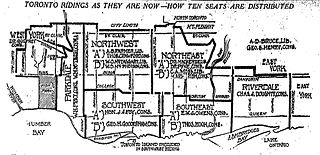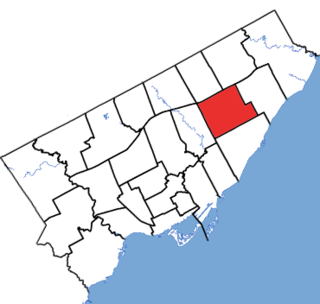
St. Andrew was a provincial electoral district in Ontario, Canada, that was established to elect Members of the Legislative Assembly (MLAs) and then Members of Provincial Parliament (MPPs) to the Legislative Assembly of Ontario.
High Park—Swansea was a provincial riding in the west-end of the city of Toronto, Ontario, Canada. It was represented in the Legislative Assembly of Ontario from 1975 to 1999.

Riverdale was a provincial riding in Ontario, Canada that existed from 1914 to 1999. It occupied an area east of the Don River from the city limits just north of Danforth Avenue south to Lake Ontario. It was named after the neighbourhood of Riverdale. In 1999 a major reduction in Ontario seats resulted in Riverdale being merged with part of East York into a larger riding called Broadview-Greenwood.
York South was a provincial riding in Ontario, Canada, that was represented in the Legislative Assembly of Ontario from 1926 to 1999.

Dovercourt was the name of a provincial riding in Ontario, Canada. It existed from the 1926 election to the 1999 election. When it was established, it bordered Brockton on to the west, York South to the north, and Bracondale on the east. Lake Ontario was its southern border for most of its existence. At its abolition in 1999, it consisted of that part of the city of Toronto bounded on the north by the former city limits, on the east by Bathurst Street, on the south by Bloor Street and on the west by the CN Railway and St. Clair Avenue. It was redistributed into Davenport, St. Paul's and Trinity—Spadina ridings.

Eglinton was a provincial electoral district located in Toronto, Ontario. From 1926 until 1999 it elected members to the Legislative Assembly of Ontario. At its abolishment in 1999 it consisted of the neighbourhoods of Davisville and Lawrence Park in the north end of the old city of Toronto. It was abolished into Eglinton—Lawrence, Don Valley West and St. Paul's.

George Horace Gooderham was a Canadian businessman and politician. From 1908 to 1919, he was a Conservative member in the Legislative Assembly of Ontario, representing Toronto South and then Toronto Southwest.

St. George was a provincial riding in Ontario, Canada, that returned Members of Provincial Parliament (MPPs) to the Legislative Assembly of Ontario at Queen's Park. It was created in downtown Toronto in 1926 and was merged into the riding of St. George—St. David in 1987. The seat covered much of the city's central core, roughly similar to the current riding of Toronto Centre. At its dissolution it stretched from University Avenue to Parliament Street and from the waterfront north past St. Clair.

St. David was an Ontario provincial riding that existed from 1926 to 1987. It covered a section of the eastern city of Toronto east of Sherbourne Street and west of the Don River. The riding lasted until 1987 when it was merged with the neighbouring St. George to create a larger district called St. George—St. David.

Woodbine was an Ontario provincial electoral district that existed from 1926 to 1967. It covered a section of the eastern city of Toronto east of Jones Avenue and west of Woodbine Avenue. In 1966 there was a major redrawing of the riding boundaries in Toronto and the riding was split. The portion east of Greenwood Avenue was merged into the Beaches—Woodbine and the portion west went into the Riverdale riding.

Scarborough Centre is a provincial electoral district in Ontario, Canada, that has been represented in Legislative Assembly of Ontario since 1963.

High Park was a provincial electoral district in the west-end of the old City of Toronto, Ontario, Canada. It was represented in the Legislative Assembly of Ontario from 1926 to 1975. It was mostly redistributed into the High Park—Swansea electoral district for the 1975 Ontario general election.

Toronto Southwest was an Ontario provincial electoral district in the old City of Toronto's west-end. It was represented in the Legislative Assembly of Ontario from 1914 until 1926, when it was abolished and redistributed into the Brockton, Dovercourt, Bracondale, Bellwoods, St. Andrew, and St. Patrick districts. It had two seats in the Legislature: Seat A and Seat B.

Toronto Southeast was an Ontario provincial electoral district that existed from 1914 to 1926. It occupied an area south of College and Gerrard between University and Logan Ave. In 1926 there was a major redistribution of Ontario seats which resulted in Toronto Southeast being split between three new ridings: St. George, St. David, and Riverdale.

Toronto Northeast was an Ontario provincial electoral district that existed from 1914 to 1926. It occupied an area north of College and Gerrard between University and Logan Ave. In 1926 there was a major redistribution of Ontario seats which resulted in Toronto Northeast being split between four new ridings called St. Patrick, St. George, St. David, and Eglinton.

Toronto Northwest was an Ontario provincial electoral district that existed from 1914 to 1926. It occupied an area north of College and Gerrard between Lansdowne and Spadina. In 1926 there was a major redistribution of Ontario seats which resulted in Toronto Northwest being split between five new ridings called from west to east, Brockton, Dovercourt, Bellwoods, St. Andrew, and St. Patrick.
Humber was a provincial electoral district (riding) in Ontario, Canada. It was created prior to the 1955 provincial election from parts of the York West and York South ridings. It was eliminated in 1996, when most of its territory was incorporated into the ridings of Etobicoke Centre and Etobicoke—Lakeshore. Humber was located in the municipalities of York, Toronto, and Etobicoke.

Toronto East, also known as East Toronto, was a provincial riding that was created in Toronto, Ontario when the country of Canada was established in 1867. At the time Toronto was divided into two ridings, East Toronto and West Toronto. In 1886, these ridings were dissolved and a combined riding of the entire city was created which elected three members. In 1894 this riding was split into four parts of which Toronto East was one. It occupied the eastern part of the old city of Toronto. From 1908 to 1914 it elected two members to the legislature.

Toronto West, also known as West Toronto, was a provincial riding that was created in Toronto, Ontario when the country of Canada was established in 1867. At the time Toronto was divided into two ridings, West Toronto and East Toronto. In 1886, these ridings were dissolved and a combined riding of the entire city was created which elected three members. In 1894 this riding was split into four parts of which Toronto West was one. It occupied the western part of the old city of Toronto. From 1908 to 1914 it elected two members to the legislature.

Toronto North, also known as North Toronto, was a provincial riding that was created in Toronto, Ontario in 1894. It was in use until 1914.







